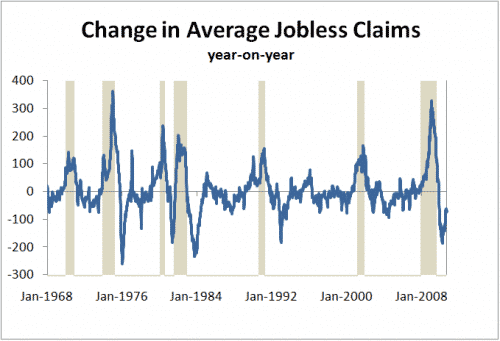US Jobless claims fall to 453,000; decline in line with past cycles
From the U.S. Department of Labor:
In the week ending Sept. 25, the advance figure for seasonally adjusted initial claims was 453,000, a decrease of 16,000 from the previous week’s revised figure of 469,000. The 4-week moving average was 458,000, a decrease of 6,250 from the previous week’s revised average of 464,250.
Unadjusted claims are lower at this time of year, now under 400,000 for three consecutive weeks. Jobless claims are coming down, but at a snail’s pace. For example at this time last year unadjusted claims were running at 430-450K versus the 340-380K we see today. The reduction in the four-week average jobless claims in that year is 71,150.
The key, however, is that the year-on-year change in claims is going down very quickly. For example, in April the decline peaked at 183K, falling to about a 100K decline in July to the present 70K. Should we be worried? Not necessarily. Last cycle, we never got that powerful a kick in jobless claims reduction, the numbers only reached the best year-on-year comparisons in April 2004 at -80K. By comparison, in the aftermath of the 1990-91 in the US, the best year-on-year comparison was –183K in January 1993. They also fell quite quickly to only a 70K reduction by April 1993.
To me, this says that the jobless claims numbers are not really that much out of line with the past two cycles of jobless recoveries. Bottom line: the jobs picture in the U.S. is still pretty weak with initial claims averaging a recessionary 458,000. Nevertheless, the numbers are still in line with a weak recovery at this point in the cycle.

Just wondering, but has anyone considered any special factors which may be contributing to the slowly declining number of first time claims for unemployment insurance? For instance, the fact that so many people have lost their jobs, only to be rehired by another employer, but laid off again before they could qualify for unemploment insurance? Another possible contributing factor could be that so many workers have already lost their jobs, one wonders how much more downsizing can occur before existing business models go completely out the window. Yet another possibility to consider is the fact that employers have cut employee hours so much that as the employees are let go, they no longer qualify for unemployment benefits. I am sure there are also other factors to consider so I won’t try to list them all here. However, I am wondering why no one EVER commentates on what the contributing factors for chages in the decline in first time claims for unemployment insurance. Why is this? These weekly reports are almost always discussed in isolation with very little context beyond the data in the most recent report. Is this laziness, or the complexity of the underlying issues involved? Just wondering.
Reporters just report the numbers without any analysis of the trends and what they mean. Economists and financial analysts generally look to the trends and make comparisons to past cycles as I have done. That said, it’s just not possible to definitively say in real time whether qualification for benefits is a major or minor contributing factor. The data just aren’t there to say one way or the other.
When a worker is laid off for the first time, he/she typically qualifies for unemployment comp and files a first-time claim. That is an initial claim and shows up in the 453,000 stat that we saw today. Every couple of weeks, when that worker re-files, it is then counted as a continuing claim – the 4.4 million figure. When the six months of regular insurance runs out and he/she qualifies for an emergency extension, it is neither a first time nor continuing claims.
If that worker is rehired in a contract or permanent role and is then laid off a short time later and still has regular benefits, he/she can normally re-file, but it is under the original claim and is NOT counted as an initial claim.
It is difficult to accurately comment on weekly changes as the data can be volatile. The 4-week moving average helps to smooth these out. But weekly initial claims are best looked at in the context of a general trend.
Since the start of the year, claims have been stuck between about 450k-500k, not very encouraging, however, it is a sign we aren’t slipping into a new recession.
In my view, weekly claims are an excellent barometer of economic health, as the figure provides a concrete look at business confidence. Falling claims indicate businesses are doing better. Conversely, a rising trend is viewed negatively signals worsening conditions.
Charles
http://www.economy-tomorrow.com
It’s not true that jobless claims suggest we are headed to recession at all. In fact, if you look at the last recovery, average jobless claims peaked at 489K in October 2001, they then fell by 100K by July of 2002, only to rise back to almost 440K by May 2003. They stayed at this elevated level until September 2003, a full two years after the recession had ended.
So to say that a level of 450K is “a sign we aren’t slipping into a new recession” is not accurate. The claims numbers are worrying but in and of themselves are not giving off that signal.